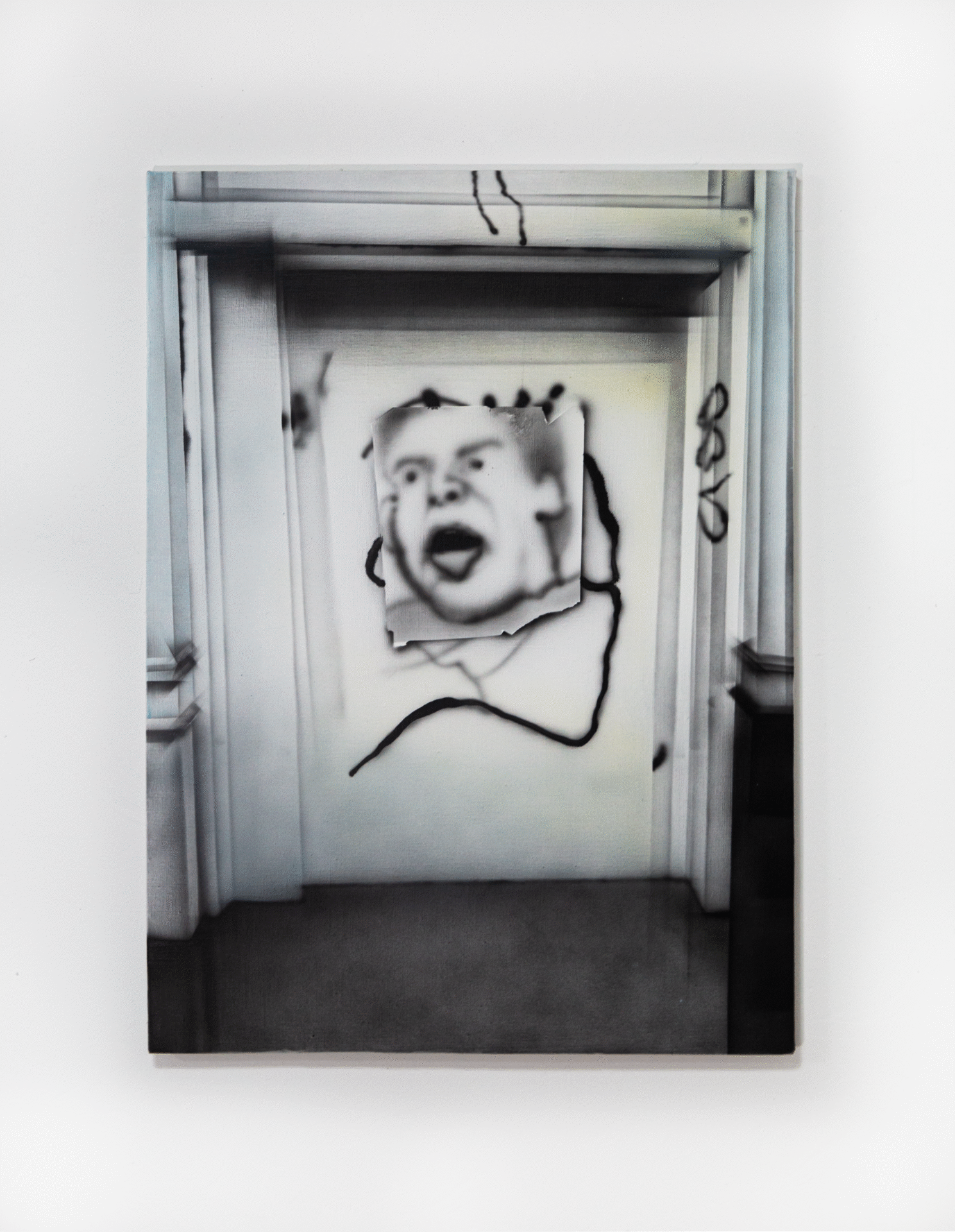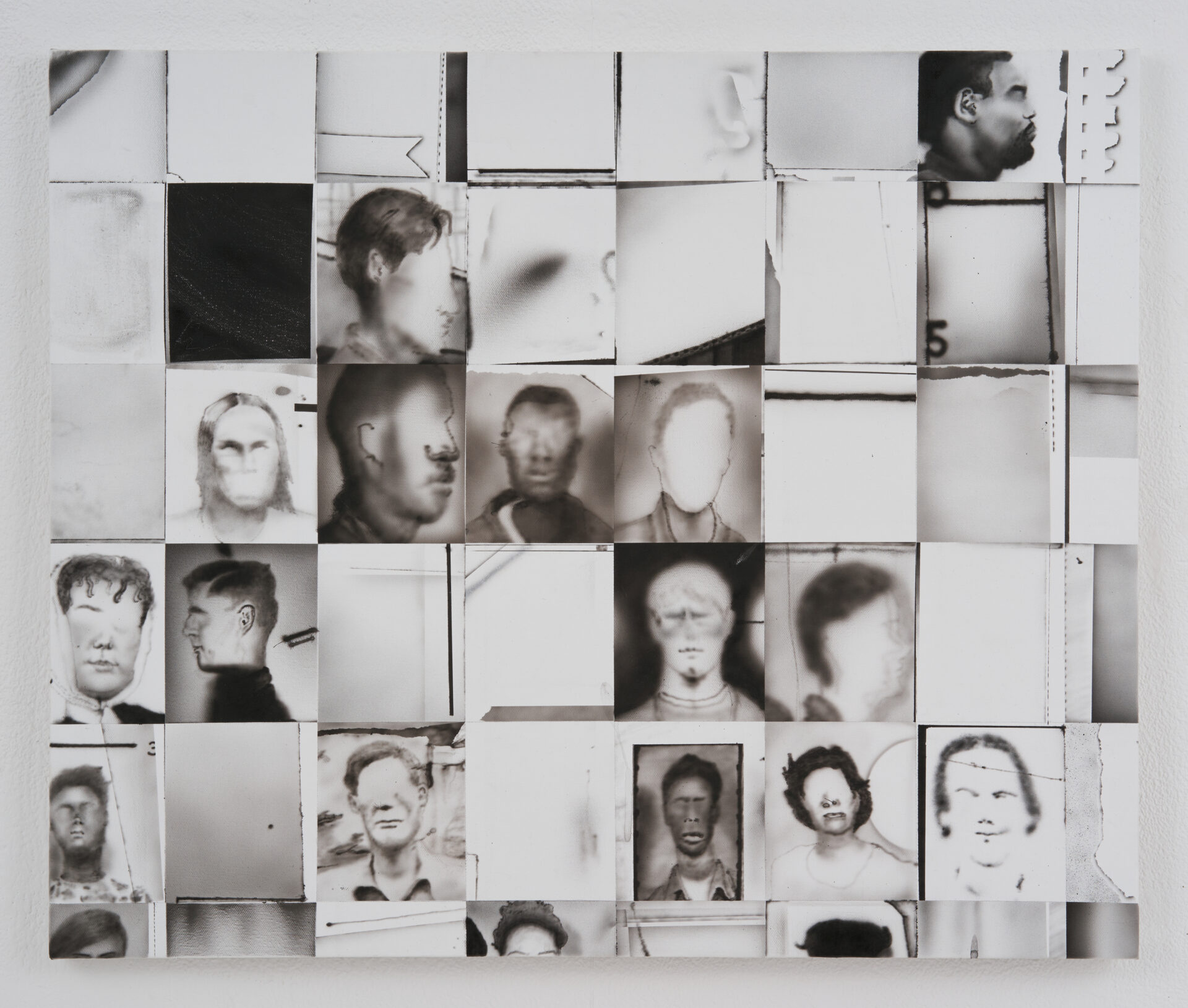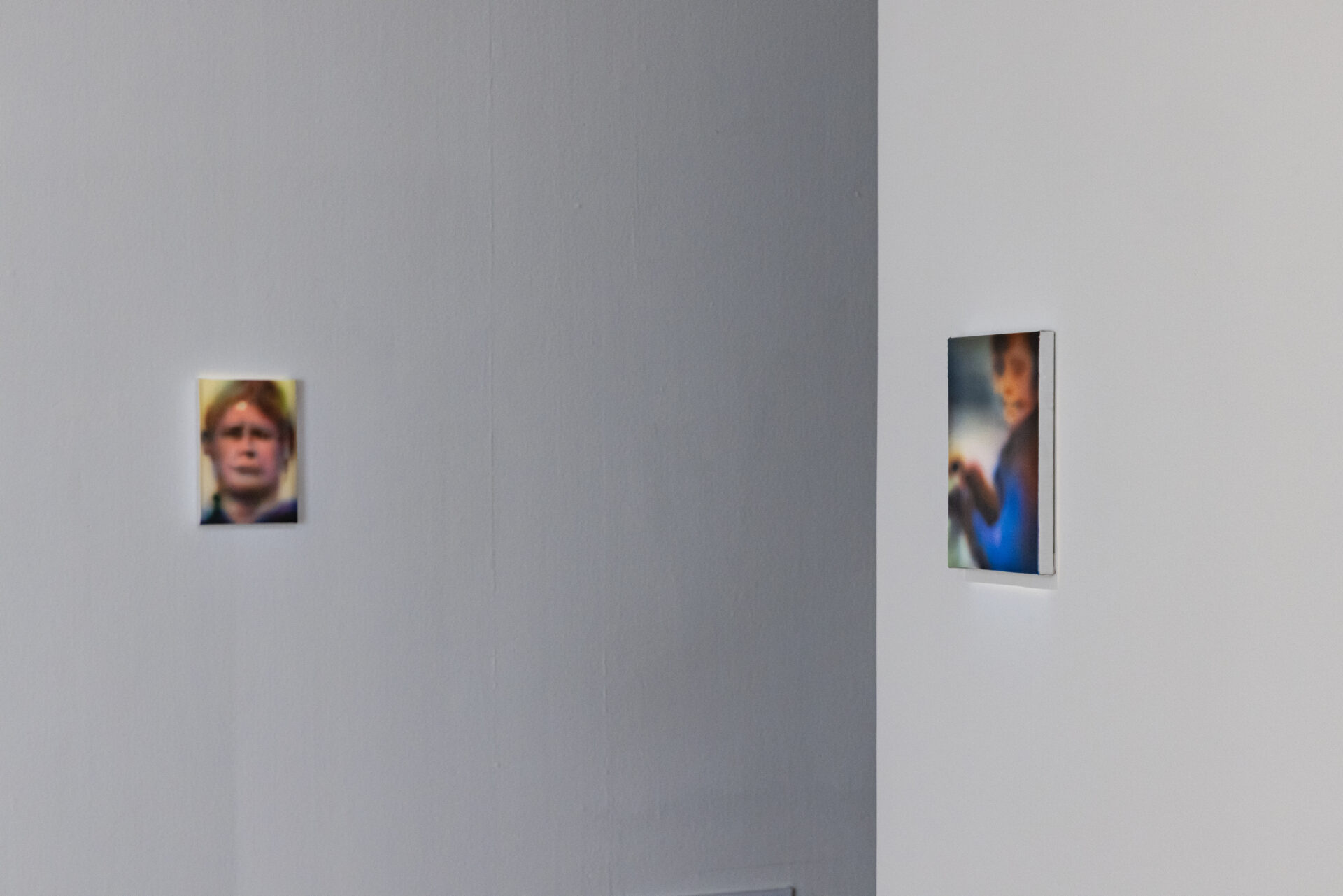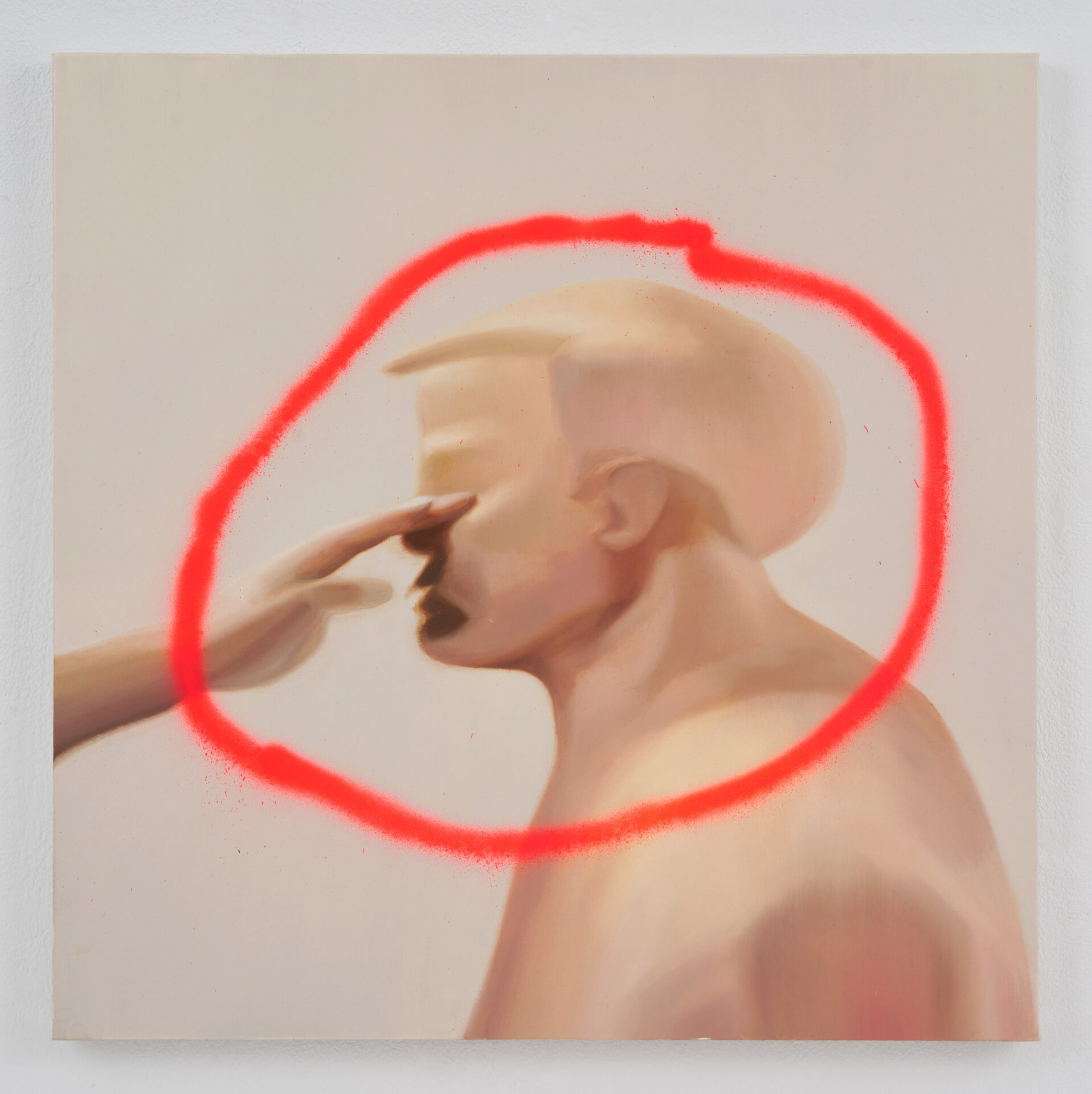〈Lonely Man on the Wall〉은 공간과 이미지의 경계가 만나 독특한 공간감을 보여주는 작품이다. 화면 중앙에 입을 벌린 채 비명을 지르는 듯한 표정의 인물은 거칠게 잘린 혹은 찢긴 종이 위에 그려져 있다. 이는 전단이나 선거 포스터를 연상시키는데, 인물의 이미지 주변으로 그려진 그래피티(graffiti)는 공간을 점유하며 자유롭게 낙서 되어 있다. 캔버스 프레임과 수평적으로 그려진 화면 속 건축 구조물은 이미지의 모서리와 함께 납작하면서도 깊은, 얇으면서도 두터운 공간을 만든다. 이처럼 장예빈은 2차원의 이미지, 3차원의 공간으로 존재의 여러 층위를 보여주며, 각 층위를 통해 이루어지는 전환의 감각을 전달한다. 이는 회화를 통해 영상의 시간을 이미지의 순간으로, 이미지의 순간을 다시 상상의 여정으로 이동시키고자 하는 작가의 탐구이자 실험을 대변한다.
〈Missing Eyes〉는 머그샷(mugshot), 즉 범인 식별용 사진에서 출발한 그림이다. 장예빈이 그린 머그샷 속 인물들은 눈이 생략되어 있는데, 이러한 표현은 디지털 시대의 이미지 소비 방식과 그 속에서 상실되어 가는 인간성에 관한 질문을 담고 있다. 눈이 없는 얼굴들은 볼 수 있는 기능을 상실한 채 그저 보이는 대상이 된다. 작가는 이 작품을 통해 우리가 이미지를 생산하고 그것을 소비하고 있지만, 이는 ‘본다’라는 적극적인 행위와 연결될 수 없으며 우리 또한 이미지가 되어 유통될 수 있음을 경고한다.
〈Face〉 연작은 자연물이나 인공물의 표면에서 발견되는 우연한 패턴과 질감을 마치 인간의 얼굴인 듯 읽어내려는 현상을 탐구한 작업이다. 작가는 사물의 움푹 팬 부분이나 돌출된 형태 등 최소한의 요소만으로 눈과 입의 위치를 정하고 표정을 감지하는 파레이돌리아(pareidolia) 또는 변상증(變像症)에 주목하여 대상을 바라보는 우리의 시각에 대해 질문한다. 그리고 장예빈은 이 작품을 통해 일상적인 사물에서 끊임없이 의미와 존재를 찾으려 하는 인간의 근원적 성향을 보여준다.
〈Grass is Greener〉는 축구 경기 중 넘어진 선수의 모습을 작품의 소재로 삼는다. 스포츠 중계방송에서 ‘스크린샷’으로 정지시킨 이 장면은 장예빈의 회화에선 ‘누워있는’ 남성의 모습으로 전환된다. 잔디가 아닌 오염 가득한 콘크리트 바닥, 선수들 대신 이름 모를 행인의 다리, 어떤 표정인지 알 수 없는 인물의 얼굴 등은 ‘넘어진’ 좌절의 상황을 묘한 장면으로 바꾼다. 작품 제목 “풀은 더 푸르다 (Grass is Greener)”는 영어 속담인 “남의 잔디가 항상 더 푸르게 보인다 (The grass is always greener on the other side)”에서 가져왔는데, 이 속담은 다른 사람의 것이 나아 보여도 막상 그 사람의 자리에 가서 보면 별 차이가 없음을 의미한다. 장예빈 작가는 이와 같은 속담을 빌어 이미지가 놓이는 맥락에 따라 장면과 상황이 달리 보일 수 있음을 전달한다.
〈Critical Hit〉은 결정타를 맞는 한 인물의 모습을 담고 있다. 시간을 알 수 없는 단일한 톤의 배경 위로 한 인물과 또 다른 인물의 손이 부딪히고 있다. 장예빈은 이 찰나의 순간을 강조하기 위해 스프레이로 삐뚤삐뚤한 동그라미를 그렸는데, 이 동그라미로 인해 관객은 이미지가 내포한 이야기에 주목하기보다 ‘결정타(critical hit)’의 순간만을 감상하게 된다. 작가는 이러한 시각의 작동이 오히려 이미지에 대한 해석을 자유롭게 만든다고 생각했다. 이 작품은 또한 생략의 방식을 적극 사용했는데, 흐릿한 인물의 얼굴과 맥락 없는 제스처만을 남겨둠으로써 특정 인물의 이야기가 아닌 보편적인 순간, 즉 어느 무엇이든, 누구나의 이야기가 될 수 있는 순간을 관객에게 제시한다.
Lonely Man on the Wall presents a distinctive sense of space where the boundaries between image and space converge. At the center of the canvas, a figure with an open mouth—seemingly caught mid-scream—is painted on a surface that looks like a roughly cut or torn piece of paper. The torn-paper visual evokes the look of flyers or election posters, while graffiti drawn around the figure claims the surrounding space with free and spontaneous strokes. Architectural forms drawn horizontally within the image, aligned with the canvas frame, combine with the image’s edges to construct a space that feels flat yet deep, thin yet dense. Through the interplay between two-dimensional images and three-dimensional space, Chang reveals multiple layers of presence and conveys a sense of transition between them. This embodies Chang’s exploration and experimentation in transforming the temporality of video into the moment of an image, and from that moment into a journey of imagination through painting.
Missing Eyes originates from mugshots—photographs used for criminal identification. In Chang’s painting, the figures appear without eyes, a gesture that questions how images are consumed in the digital age and what is lost in the process. Deprived of the ability to see, these eyeless faces become mere objects to be looked at. Through this work, Chang warns that producing and consuming images is no longer connected to the active, intentional act of ‘seeing’—and that we ourselves risk becoming mere images in circulation.
The Face series explores the tendency to perceive accidental patterns and textures on natural or man-made surfaces as resembling human faces. Chang focuses on pareidolia and metamorphopsia—phenomena in which we recognize facial expressions by identifying the positions of eyes and mouth from minimal visual cues, such as concave or protruding forms in objects. Through this, she questions how we see and make sense of what we perceive. Through these works, she reveals a fundamental human tendency: the urge to find meaning and a sense of presence—even in the ordinary and overlooked.
Grass is Greener takes as its subject the image of a soccer player who has fallen during a match. Captured as a ‘screenshot’ from a sports broadcast, the scene is transformed in Chang’s painting into a male figure ‘lying on the ground.’ But instead of grass, he rests on a stained concrete floor. In place of other players, we see the legs of nameless passersby. The figure’s face, with no discernible expression, turns this moment of collapse into a scene both strange and ambiguous. The title ‘Grass is Greener’ comes from the English proverb “The grass is always greener on the other side,” which suggests that others’ circumstances often seem more appealing from a distance, but rarely differ in reality. By invoking this saying, Chang conveys how an image can shift in meaning depending on the context in which it is placed.
Critical Hit depicts a figure struck by a decisive blow. Set against a monochromatic backdrop suspended in time, the hands of one figure and the eyes of another collide. To highlight this fleeting moment, Chang spray-paints a crooked circle around the point of contact, pulling the viewer’s gaze away from narrative possibilities and toward the moment of ‘critical hit.’ The artist saw this redirection of gaze not as a limitation, but as a way of opening up the viewer’s interpretation of the image. The work makes active use of omission. By leaving only a blurred face and a gesture devoid of context, the artist offers not the story of a specific person, but a universal moment—one that could belong to anyone, or anything.




